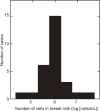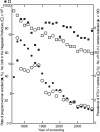Establishment of the milk-borne transmission as a key factor for the peculiar endemicity of human T-lymphotropic virus type 1 (HTLV-1): the ATL Prevention Program Nagasaki
- PMID: 21558754
- PMCID: PMC3149377
- DOI: 10.2183/pjab.87.152
Establishment of the milk-borne transmission as a key factor for the peculiar endemicity of human T-lymphotropic virus type 1 (HTLV-1): the ATL Prevention Program Nagasaki
Abstract
In late 2010, the nation-wide screening of pregnant women for human T-lymphotropic virus type 1 (HTLV-1) infection was implemented in Japan to prevent milk-borne transmission of HTLV-1. In the late 1970s, recognition of the adult T-cell leukemia (ATL) cluster in Kyushu, Japan, led to the discovery of the first human retrovirus, HTLV-1. In 1980, we started to investigate mother-to-child transmission (MTCT) for explaining the peculiar endemicity of HTLV-1. Retrospective and prospective epidemiological data revealed the MTCT rate at ∼20%. Cell-mediated transmission of HTLV-1 without prenatal infection suggested a possibility of milk-borne transmission. Common marmosets were successfully infected by oral inoculation of HTLV-1 harboring cells. A prefecture-wide intervention study to refrain from breast-feeding by carrier mothers, the ATL Prevention Program Nagasaki, was commenced in July 1987. It revealed a marked reduction of HTLV-1 MTCT by complete bottle-feeding from 20.3% to 2.5%, and a significantly higher risk of short-term breast-feeding (<6 months) than bottle-feeding (7.4% vs. 2.5%, P < 0.001).
Figures




References
-
- Uchiyama T., Yodoi J., Sagawa K., Takatsuki K., Uchino H. (1977) Adult T cell leukemia: clinical and hematological features of 16 cases. Blood 50, 481–491 - PubMed
-
- National Cancer Center (2011) Cancer Mortality 2009 by ICD10 classification. 10. Cancer mortality rate by prefecture. http://ganjoho.ncc.go.jp/data/public/statistics/backnumber/2010/files/da... (Accessed on Feb. 4, 2011).
-
- Doi H. (2009) Adult T-cell leukemia and cancer registration in Nagasaki. JACR Monogr. 4, 5–8(in Japanese)
-
- Miyoshi I., Kubonishi I., Yoshimoto S., Ohtsuki Y., Akagi T. (1984) Tumorigenicity of a rabbit lymphoid cell line transformed by human T-cell leukemia virus. Gann 75, 482–484 - PubMed

